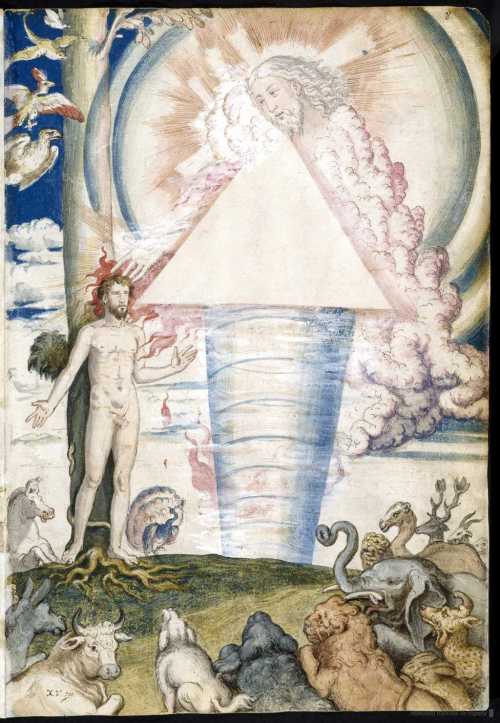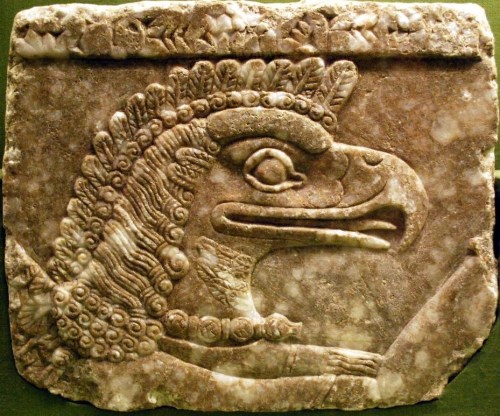Eco: Before and After Europe, 3

Francisco of Holland, 1543-73, De aetatibus mundi imagines, Creation of Man, Biblioteca Nacional de España. This work is in the public domain in its country of origin and other countries and areas where the copyright term is the author’s life plus 100 years or less.
“There is one sense in which St. Augustine did have a clear idea of a perfect language, common to all people. But this was not a language of words; it was, rather, a language made out of things themselves.
He viewed the world, as it was later to be put, as a vast book written with God’s own finger. Those who knew how to read the book were able to understand the allegories hidden in the scriptures, where, beneath references to simple earthly things (plants, stones, animals), symbolic meanings lay.
This Language of the World, instituted by its creator, could not be read, however, without a key; it was the need to provide such a key that provoked a rapid outflowing of bestiaries, lapidaries, encyclopedias and imagines mundi throughout the Middle Ages.
This represents a tradition that will resurface in our own story as well: European culture will sometimes seize upon hieroglyphs and other esoteric ideograms, believing that truth can only be expressed in emblems or symbols.
Still, St. Augustine’s symbolic interests were not combined with the longing to recover a lost tongue that someone might, or ought to, speak once again.
For Augustine, as for nearly all the early Fathers, Hebrew certainly was the primordial language. It was the language spoken before Babel. After the confusion, it still remained the tongue of the elected people.
Nevertheless, Augustine gave no sign of wanting to recover its use. He was at home in Latin, by now the language of the church and of theology.
Several centuries later, Isidore of Seville found it easy to assume that, in any case, there were three sacred languages–Hebrew, Greek and Latin–because these were the three languages that appeared written above the cross (Etymologiarum, ix, 1).
With this conclusion, the task of determining the language in which the Lord said “fiat lux” became more arduous.
If anything, the Fathers were concerned about another linguistic puzzle: the Bible clearly states that God brought before Adam all the beasts of the field and all the fowl of the air. What about the fish? Did Adam name the fish? Maybe it seemed inconvenient dragging them all up from the briny deep to parade them in the garden of Eden.
We may think this a slight matter; yet the question, whose last trace is to be found in Massey’s Origins and Progress of Letters published in 1763 (cf. White 1917: II, 196), was never satisfactorily resolved, despite Augustine’s helpful suggestion that the fish were named one at a time, as they were discovered (De Genesi ad litteram libri duodecim, XII, 20).
Between the fall of the Roman Empire and the early Middle Ages, when Europe had still to emerge, premonitions of its linguistic future lurked unrecorded. New languages came slowly into being. It has been calculated that, towards the end of the fifth century, people no longer spoke Latin, but Gallo-Romanic, Italico-Romanic or Hispano-Romanic.
While intellectuals continued to write in Latin, bastardizing it ever further, they heard around them local dialects in which survivals of languages spoken before Roman civilization crossed with new roots arriving with the barbarian invaders.
It is in the seventh century, before any known document written in Romance or Germanic languages, that the first allusion to our theme appears. it is contained in an attempt, on the part of Irish grammarians, to defend spoken Gaelic over learned Latin.
In a work entitled Auracepit na n-Éces (“the precepts of the poets”), the Irish grammarians refer to the structural material of the tower of Babel as follows:
“Others affirm that in the tower there were only nine materials, and that these were clay and water, wool and blood, wood and lime, pitch, linen, and bitumen. . . . These represent noun, pronoun, verb, adverb, participle, conjunction, preposition, interjection.”
Ignoring the anomaly of the nine parts of the tower and only eight parts of speech, we are meant to understand that the structure of language and the construction of the tower are analogous. This is part of an argument that the Gaelic language constituted the first and only instance of a language that overcame the confusion of tongues.
It was the first, programmed language, constructed after the confusion of tongues, and created by the seventy-two wise men of the school of Fenius. The canonic account in the Precepts
“shows the action of the founding of this language . . . as a “cut and paste” operation on other languages that the 72 disciples undertook after the dispersion. . . . It was then that the rules of this language were constructed. All that was best in each language, all there was that was grand or beautiful, was cut out and retained in Irish. . . . Wherever there was something that had no name in any other language, a name for it was made up in Irish. (Poli 1989: 187-9).”
This first-born and, consequently, supernatural language retained traces of its original isomorphism with the created world. As long as the proper order of its elements was respected, this ensured a sort of iconic bond between grammatical items and referents, or states of things in the real world.”
Umberto Eco, The Search for the Perfect Language, translated by James Fentress, Blackwell. Oxford, 1995, pp. 14-7.


